NOTE: This website was always intended as stand-alone reference material, and I had no intention of adding to it or keeping it “current.” However, the following information is of such magnitude that I felt an update was essential.
UPDATE 3-15-2022:
As a result of the legal complaint filed by Public Health and Medical Professionals for Transparency on September 16, 2021, Pfizer has finally been compelled by court order to release documents regarding adverse effects associated with its vaccine. During just the first three months of the vaccine rollout (December 2020 through February 2021), there were 42,086 individual adverse event case reports, the great majority of which were medically confirmed and many of which involved multiple adverse events (for a total of 158,893 adverse events).
As shown by the chart on page 7 of their report entitled “Cumulative Analysis of Post-authorization Adverse Event Reports,” there were 25,957 nervous system disorders, 17,283 musculoskeletal and connective tissue disorders, and 14,096 gastrointestinal disorders, among thousands of others reported.
Nearly two-thirds of the cases were people in their 30s and 40s – or even younger. Over 45% were under the age of 65.
Most disturbing of all are the 1,223 vaccine-related fatalities reported – just during those first three months of vaccine distribution. Additionally, as we consider this shocking number, it is essential to note that because physicians – and the public – were constantly assured that the vaccines were “safe and effective,” this number does not include any post-vaccine fatalities that were considered coincidental (and therefore not reported in connection with the vaccine or included in the Pfizer report) but, in fact, may have been vaccine-related.
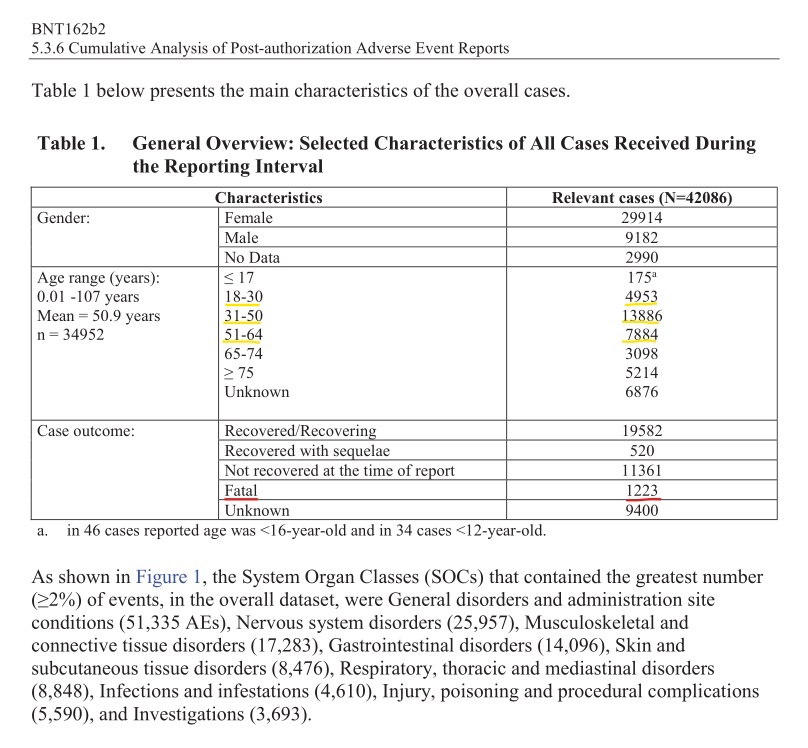
Incredibly, despite the huge number of adverse events and the alarming number of fatalities reported and recorded, the Pfizer vaccine was nevertheless given FDA approval on August 23, 2021.
This information, documented by Pfizer but hidden from the public for well over a year (and only released in March 2022 because of a court order compelling them to do so), should be sufficient to answer any lingering questions about the “safety” of the Pfizer vaccine – and to cast doubt on the value of “FDA approval” for any future product.
Dr. Ryan Cole explains (and shows) formerly rare clot formations that are now common in deceased individuals who received Covid-19 injections:
Dr. Sucharit Bhakdi gives a detailed explanation of the science behind clot formation and thrombosis caused by the Covid-19 injections:
Continue reading the original article below for more details on the vaccine and its “efficacy.”
********************
The mRNA vaccines from Pfizer and Moderna are unlike any vaccine ever administered to humans. Conventional vaccines typically contain “dead” or attenuated (weakened) virus that the body still recognizes as a pathogen (a threat to the cell) and against which it will make antibodies.
The new mRNA vaccines are much different. The injection contains mRNA (genetic code) from the SARS-CoV-2 virus, specifically, genetic code for the “spike proteins” – the distinctive protrusions on the surface of the virus. When the mRNA enters your cell, it actually causes your cell to create those spike proteins itself. Your body will then perceive those spike proteins as pathogens and make antibodies in response to the perceived threat that your own body has just produced.
Until August 23, 2021, none of the Covid-19 vaccines had been approved by the FDA. They were experimental and were being administered through an Emergency Use Authorization (EUA), under which “the use of unapproved medical products” is allowed. The FDA website clarifies, “On August 23, 2021, the FDA approved the first COVID-19 vaccine.” Many people did not know that the vaccines had not been approved, and many still don’t know that most of the vaccines are still not FDA-approved and that no vaccines have been approved for children under 16.

What do they mean when they say the Pfizer vaccine is 95% effective?
To answer this, we first have to understand how pharmaceutical companies calculate an “efficacy rate” for their products, as illustrated in this ad for Lipitor, a statin drug. The ad boldly claims that for certain patients, Lipitor reduces the risk of heart attack by a whopping 36%.
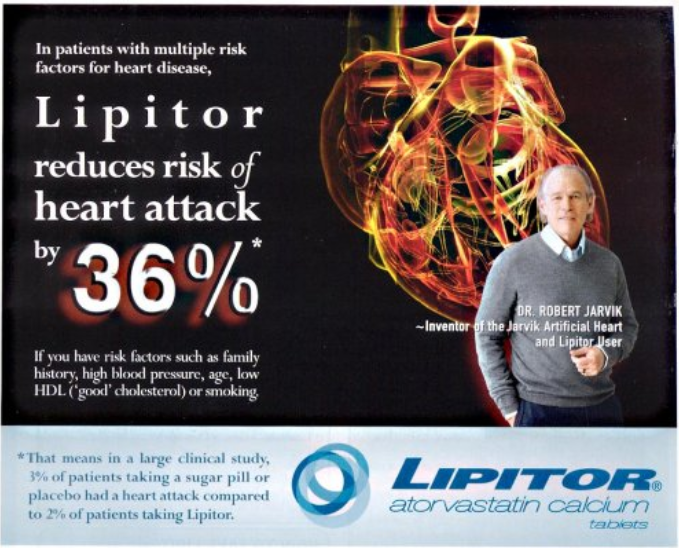
But if we follow the asterisk to the corresponding note at the bottom of the ad, we find that during the clinical study, 2% of the Lipitor patients had heart attacks, compared with 3% in the placebo group. This means that 97% of patients in the placebo group were heart attack-free, compared to 98% of the Lipitor group. But since 2% is one-third less than 3%, they are able to claim a 36% “relative risk reduction,” even though there was only about a 1% difference in the overall rate of heart attack between the two groups, as explained by Dr. David Diamond:
The Pfizer vaccine efficacy rate was calculated in the same way. Out of about 20,000 people in the placebo group, only 162 got Covid-19 during the study period. Out of the approximately 20,000 in the vaccinated group, only 8 got Covid-19. In other words, 99.19% of the placebo group did not get Covid-19, compared with 99.96% of the vaccinated group. So while Pfizer claims a relative risk reduction of 95%, there was actually a difference of only .77% in infection rate between the two groups. This is an absolute risk reduction of less than 1%.
Put visually, in this graph, the tiny red sliver at the top of the right-hand column is how many people got Covid-19 in the placebo group. The even tinier red sliver at the top of the left-hand column is how many got Covid-19 in the vaccinated group. There was a difference, to be sure, but it’s hard to believe anyone could claim a 95% efficacy rate with these numbers.
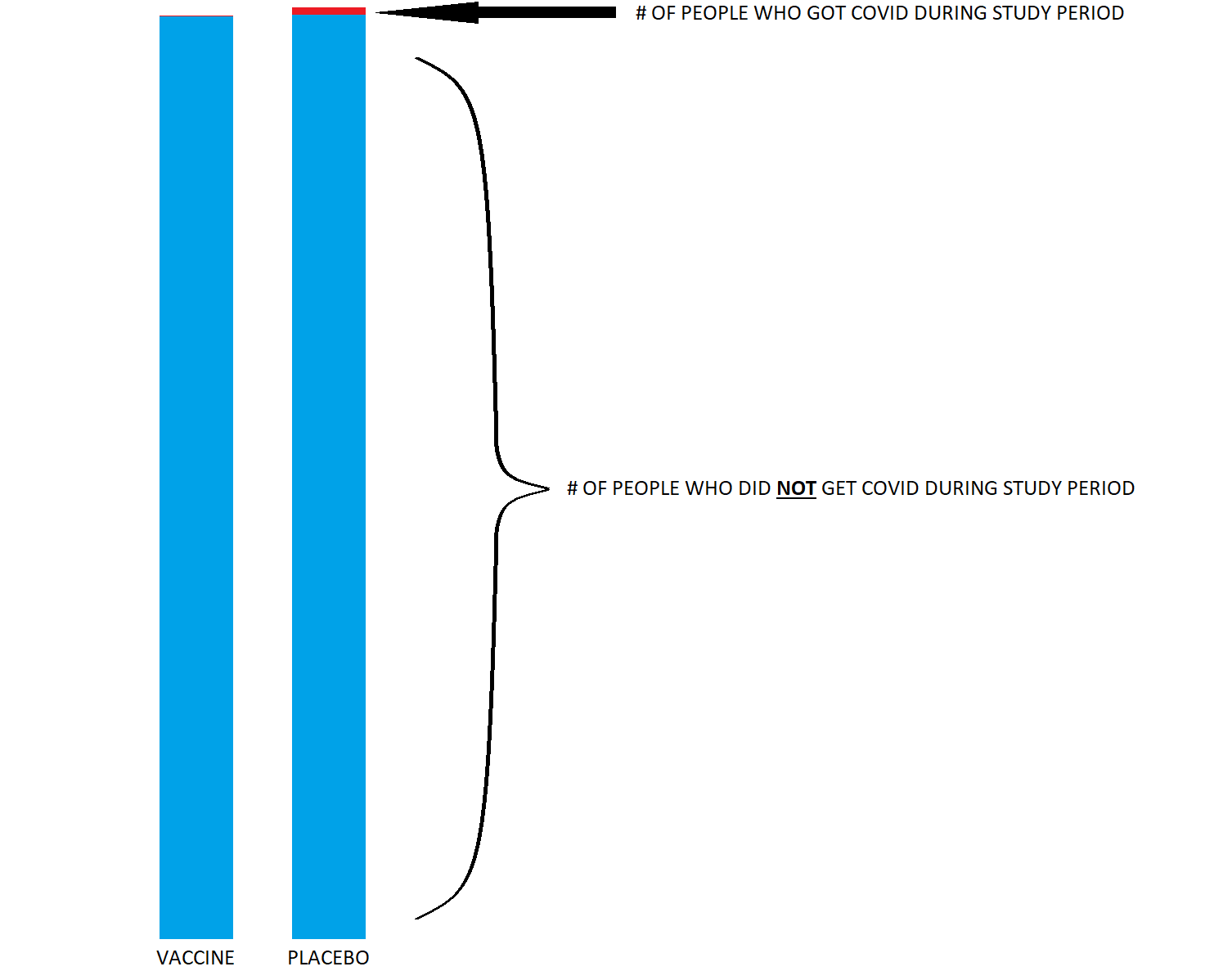
A July 2021 article in The Lancet, the world’s oldest and most well known medical journal, explains that “fully understanding the efficacy and effectiveness of vaccines is less straightforward than it might seem” and that “a quite different picture might emerge” as we look at the data. “ARRs [absolute risk reduction data] tend to be ignored because they give a much less impressive effect…” The absolute risk reduction is not above 1.3% for any of the vaccines.
There is another important aspect of this study to consider: What did the vaccinated participants give up in exchange for that tiny decrease in their odds of getting Covid-19? These charts show the data on adverse effects from pages 39 and 40 of the FDA Briefing Document for the Pfizer vaccine. The first is data for all age groups, and the second is for participants age 65 and older:
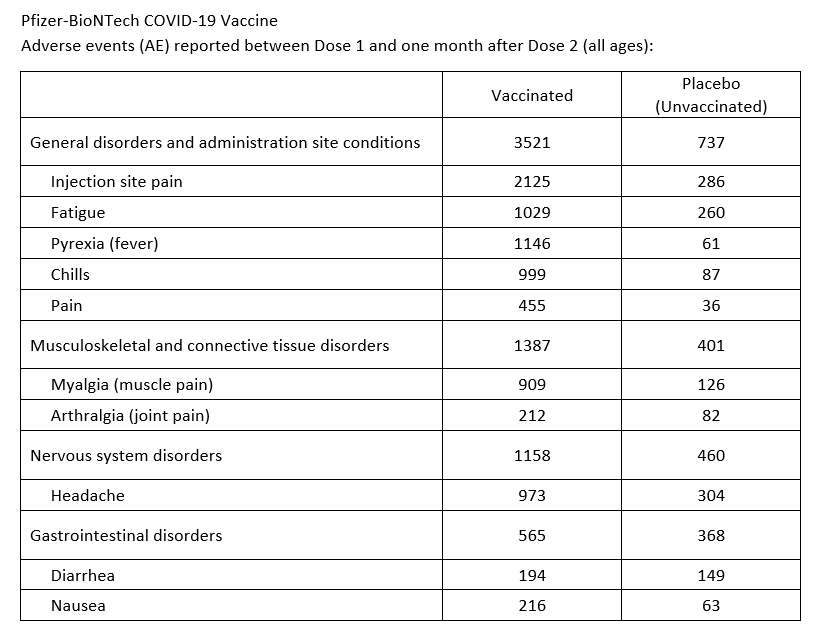
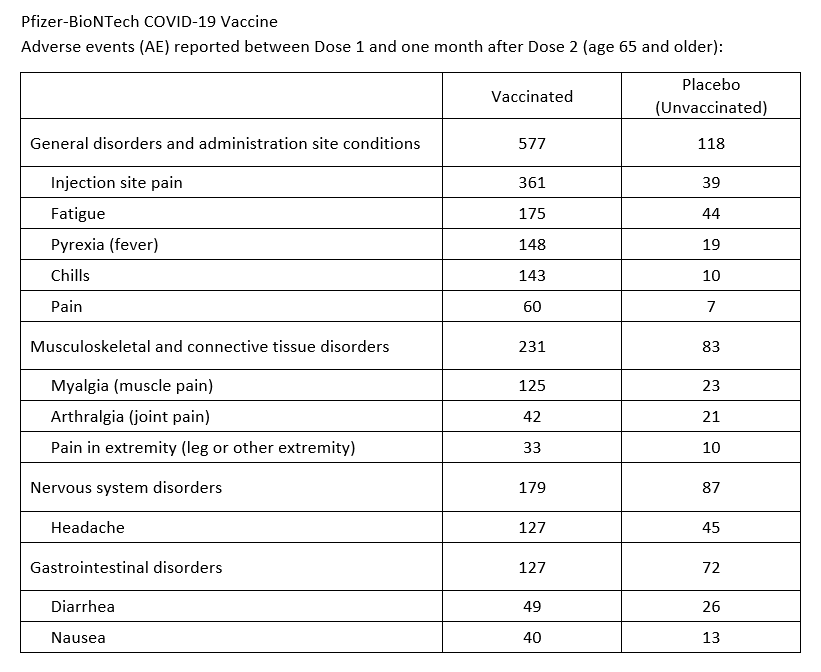
Even in the face of these statistics and numerous personal accounts of debilitating flu-like symptoms following vaccination, some are willing to brave the side effects of the vaccine in the hope that they will be allowed to “go back to normal” – shopping, socializing, and traveling without masks or physical distancing. Unfortunately, as of March 23, 2021, the CDC’s recommendations for vaccinated individuals still included wearing a mask in public, avoiding crowds, and delaying travel:
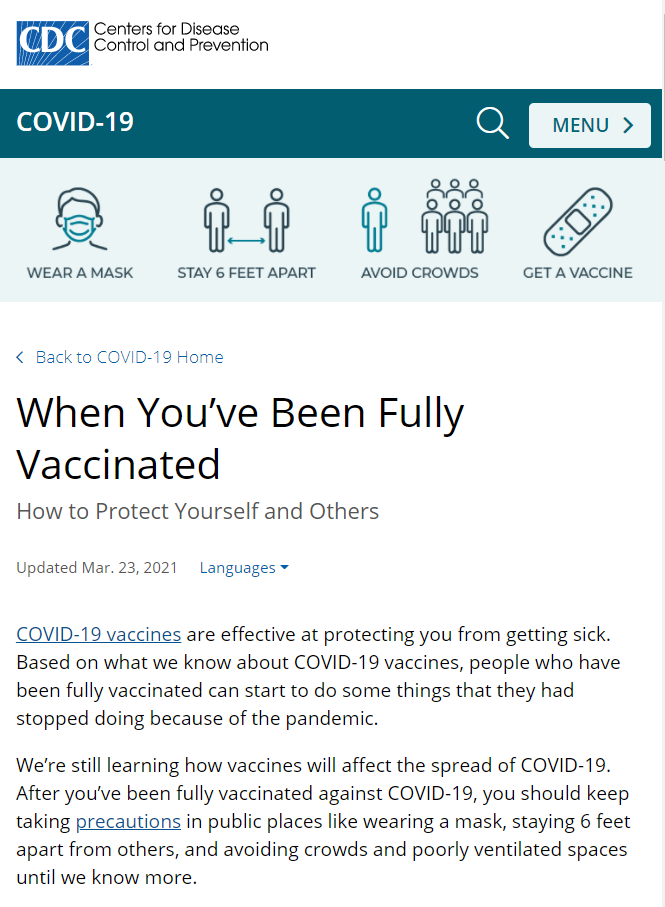
Vaccine passports
A “vaccine passport” (called the Excelsior Pass) has been launched in New York, where proof of vaccination or negative Covid-19 test was required for access to certain sports events and concerts. In some countries, vaccine passports are being used to grant or deny access to services such as hair salons, concerts, and driving schools. According to New York governor Cuomo, participation in the passport program will be free and voluntary. However, in order to “gain entry to major stadiums and arenas, wedding receptions, or catered and other [highly attended] events,” a person must show proof of vaccination/negative test.
Then what exactly does “free [and] voluntary” mean? First, it means that you are “free” to stay home and skip the wedding or the concert. Second, it means that in order to attend, you must show proof of vaccination/negative test, but you are “free” to show this mandatory proof with physical papers instead of with the Excelsior Pass. There is nothing free or voluntary about this government mandate.
Some states have vowed not to allow counties, cities, or businesses to require vaccine passports, much to the chagrin of medical analyst and former head of Planned Parenthood Dr. Leana Wen. Dr. Wen even believes that reopening economies without requiring vaccination is a big mistake and that opening businesses should be used as a reward, or “carrot,” for being vaccinated. Speaking about people who “have concerns about the vaccine,” she cautions:
“[W]e need to make it clear to them that the vaccine is the ticket back to pre-pandemic life, and…we have a very narrow window to tie reopening policy to vaccination status. Because, otherwise, if everything is reopened, then what’s the carrot going to be? How are we going to incentivize people to actually get the vaccine? So that’s why I think the CDC…needs to come out a lot bolder and say, ‘If you are vaccinated, you can do all these things. Here are all these freedoms that you have.’ Because, otherwise, people are going to go out and enjoy these freedoms anyway…”
The bottom line: none of the Covid-19 vaccines are FDA-approved; the mRNA vaccine has never been used in humans; the vaccine very often causes flu-like symptoms itself, while only slightly reducing a person’s chance of getting Covid-19; getting the shot does not allow people to resume normal, mask-free lives; and people may be coerced into getting vaccinated by restrictions on access to weddings, concerts, and even retail businesses.
____________________
Extras:
“Israel vaccination ‘green pass’ may offer a glimpse of a post-Covid future” – In Israel, people are “being scanned into restaurants after showing a special certificate known as a ‘green pass’ and everyone [is] wearing masks” even though “Israel boasts one of the highest vaccination rates in the world…”
International Air Transport Association video on IATA “Travel Pass“:
“The Crisis of Science” – excellent report by James Corbett detailing conflicts of interest, consensus-promoting funding incentives, and peer-review fraud among scientists. Interestingly, YouTube has removed this video, but it can be seen at TheCorbettReport.com.
Links and transcripts here: https://www.corbettreport.com/sciencecrisis/